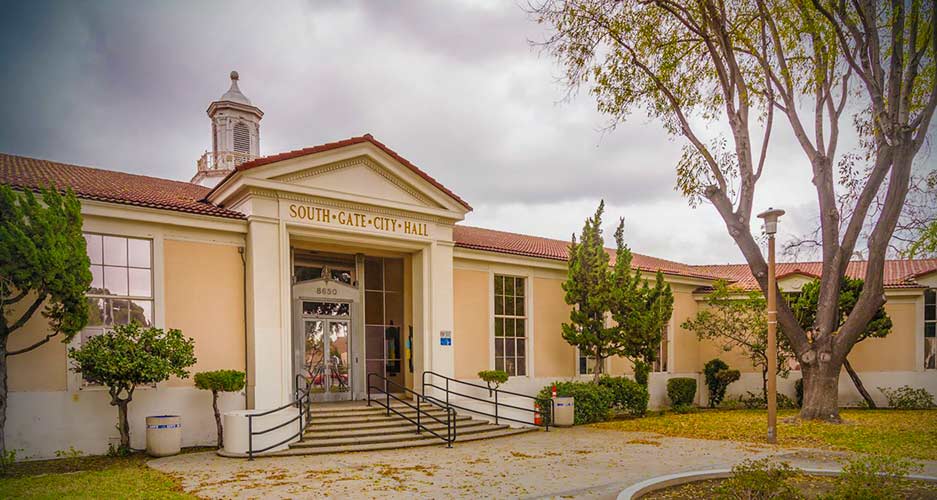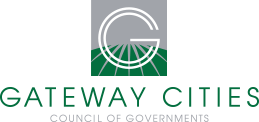Gateway Cities are working hard to adapt to changing economic trends and emerging business opportunities.
Collective Impact in the Gateway Cities

In 2015, the City of South Gate became the first recipient of the Beacon Climate and Sustainability Award from among the ranks of communities designated by the state as disadvantaged. Despite the constraints the city faces as a disadvantaged community with limited staff and fiscal resources, South Gate reduced energy use in its facilities by 12 percent and cut greenhouse gas emissions by 11 percent for its operations and 7 percent for the community as a whole, while simultaneously developing new job opportunities for the city’s 100,000 residents.
South Gate’s success inspired the Institute for Local Government, which administers the Beacon Program, and our partners in the SEEC collaborative, the Local Government Commission and ICLEI – Local Governments for Sustainability, to propose a sustainability catalyst project engaging South Gate and its neighboring communities in the Gateway Cities region. Home to over 2 million residents, the region includes 27 cities and a dozen unincorporated communities. It covers more than 200 square miles, stretching from Long Beach to the borders of downtown Los Angeles. The area was formerly the heart of Southern California’s defense and aerospace industries; today the Gateway Cities are working hard to adapt to changing economic trends and emerging business opportunities.
The Gateway Cities catalyst project was designed to help the region capitalize on the growing interest in sustainable development among local officials, businesses and community leaders in the region. Organized through a partnership with the Gateway Cities Council of Governments, the project aimed to achieve three key outcomes:
- Increase local agency knowledge about and access to climate and energy resources and funding.
- Explore opportunities for transformative local projects integrating a variety of sustainability strategies and features that could potentially compete for regional and state funding and support.
- Expand participation and accelerate progress by local agencies in achieving climate, energy and sustainability goals in the Beacon program.
Throughout 2016, the three SEEC NGOs and the SEEC Best Practices Coordinator offered ongoing support and technical assistance to the COG staff and leaders from local communities, with overall project coordination provided through ILG’s Beacon Program. Over the course of the year, the SEEC partners and the COG carried out several capacity building activities:
- Organizing two Cap-and-Trade funding workshops in March and October that each attracted 100 local officials and staff. The SEEC partners and collaborating organizations recruited key state agency, utility and NGO representatives to present at the workshops. Several participants followed up with state agencies and the utilities to explore opportunities to take advantage of the programs featured at the workshop.
- Recruiting additional cities to join the Beacon Program and implement best practices in climate action, energy and sustainability. Currently, the cities of South Gate, Whittier, Downey and Norwalk are Beacon participants, with more communities expected to join in 2017.
- Briefing COG staff and consultants on greenhouse gas emissions analysis and the role that it plays in developing competitive grants for Cap and Trade programs in the state’s Greenhouse Gas Reduction Fund. The project also connected local leaders in the Gateway Cities with outside resources, such as the Trust for Public Land’s “Climate Smart Cities” program and emissions analysis tool.
- Forging a partnership among the COG, the City of Norwalk, and the Energy Leaders program administered by Edison and SoCalGas to secure a CivicSpark fellow to work with Gateway Cities jurisdictions on energy efficiency and climate action planning. Noe Martinez began his work at the City of Norwalk in October and will be working with the COG and local jurisdictions through September, 2017.
- Collaborating with the COG to organize a Climate Planning Tools workshop in late November. The workshop provided local officials and staff with an overview of local Climate Action Plans, regional CAP frameworks, energy efficiency programs, GHG analysis with the ClearPath Inventory and Monitoring Tool, and the Beacon program.
 One important outcome of the capacity building support provided this year is the decision by the Gateway Cities COG to apply for grant funding to develop a sub-regional Climate Action Plan Framework. The sub-regional framework would provide a template for local jurisdictions to prepare their own individual Climate Action Plans. The Climate Planning Tools workshop offered in November was designed to lay the foundation for work under the grants in 2017.
One important outcome of the capacity building support provided this year is the decision by the Gateway Cities COG to apply for grant funding to develop a sub-regional Climate Action Plan Framework. The sub-regional framework would provide a template for local jurisdictions to prepare their own individual Climate Action Plans. The Climate Planning Tools workshop offered in November was designed to lay the foundation for work under the grants in 2017.
In addition to providing capacity building support to the Gateway Cities, the catalyst project was also designed to spread the ideas and lessons from the catalyst to a wider audience of local officials. This included sessions featuring South Gate’s accomplishments at the annual meetings of the League of Cities City Managers Department and the California Chapter of the American Planning Association. The work of South Gate, Downey, Norwalk and the Gateway Cites COG was also featured in article in Western City, the monthly magazine of the League of California Cities that reaches 10,000 local elected officials, staff and others statewide.
Working individually and collaboratively, the Gateway Cities are using creativity, partnerships and an entrepreneurial spirit to overcome some of the barriers that often face traditionally disadvantaged communities. These communities are determined to create a better future for their residents by pursuing sustainable development to achieve economic prosperity and improve community health and well-being. ILG and our partners in the Statewide Energy Efficiency Collaborative are grateful for the opportunity we have had to work with the dedicated leaders in the Gateway Cities and to play a part in helping their communities build a better future.
Local Government Commission Newsletters
Livable Places Update
CURRENTS Newsletter
CivicSpark™ Newsletter
LGC Newsletters
Keep up to date with LGC’s newsletters!
Livable Places Update – April
April’s article: Microtransit: Right-Sizing Transportation to Improve Community Mobility
Currents: Spring 2019
Currents provides readers with current information on energy issues affecting local governments in California.
CivicSpark Newsletter – March
This monthly CivicSpark newsletter features updates on CivicSpark projects and highlights.



